Heir to the tables: The Airtable story
Heir to the tables: The Airtable story
Heir to the tables: The Airtable story
The growth engine powering Airtable's claim to the spreadsheet throne
The growth engine powering Airtable's claim to the spreadsheet throne
The growth engine powering Airtable's claim to the spreadsheet throne



Let's start today's blog a bit differently. We're going to try to sell you a hypothetical product. A product that does everything! 🤩 Customer relationship management, event planning, leave tracking, financial reporting, performance reviews, investor relations, and even your own personal taxes! Sounds too good to be true? What if we told you this product already has 750 million monthly active users? What if we went one further and told you that you are one of these users? Introducing, Microsoft Excel. The most versatile software ever written ⚡️
If you want to see the future of B2B software, look at what Excel users are hacking together in spreadsheets today - Packy McCormick
While Excel was first made to crunch numbers, manage accounts & analyze financials, the software has moved way past its original calling and morphed into an event planner, performance tracker, and sometimes even a game 🙈 (gif below) And that brings us to the founding thesis of one of our favorite products - Airtable!
“If you’re using a spreadsheet for anything other than number-crunching, it should instead be an Airtable” - Airtable's founding thesis
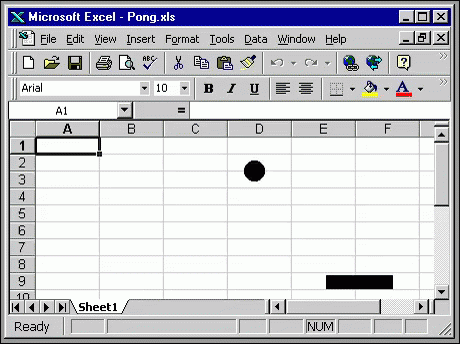
Fast forward to today and Airtable has more than lived up to this thesis. Over 200K organizations use the platform as a LEGO kit for solving a plethora of (often surprising) use-cases:
Tesla uses Airtable to track inventory of vehicles as they leave the factory
While Bret from Idaho uses Airtable to maintain a “calving database” for his cattle. An alternative to his red book used to log vaccinations, pregnancy checks, and other cattle records.
While in some ways, Airtable comes up against Excel and Google Sheets, with a combined user base larger than the population of all but two countries in the world, Airtable's founder and CEO Howie Liu thinks that their low/no-code product can expand the pie rather than compete for it, by lowering the barrier to building applications and empowering people around the world to become creators.
Airtable's fandom of power users often goes as far as describing the product as a spreadsheet on anabolic steroids! 🚀

And this isn't far from the truth! A peek under the hood of this swanky spreadsheet-looking tool reveals a powerful relational database. Here's the story of how Howie Liu, Andrew Ofstad, and Emmett Nicholas, founded and scaled Airtable to an ARR of ~$100M and a valuation of $5.77B. Let's jump right in... 👇🏻
😏 Make databases sexy again
"Spreadsheets are really optimized for numerical analysis and financial calculations. But almost 90% of spreadsheets don't have formulas. Most are used for organizing purposes."
Howie's knack for disruptive innovation is nothing new – back in 2009, he co-founded Etacts, a CRM startup that was acquired by Salesforce within a year. And that was where the "Aha!" moment hit him. He recognized that a large class of useful software was essentially a data model with an interface built on top of it sprinkled with some added customizations. Airtable speaks to the idea of consumerizing that experience, not unlike the Macintosh did for computers. The platform rallies around the central idea that structured processes that form a majority of management, production, and other tasks that represent real work deserve a better home than messy spreadsheets, ad-hoc email chains, and people tapping on shoulders for a single source of truth.
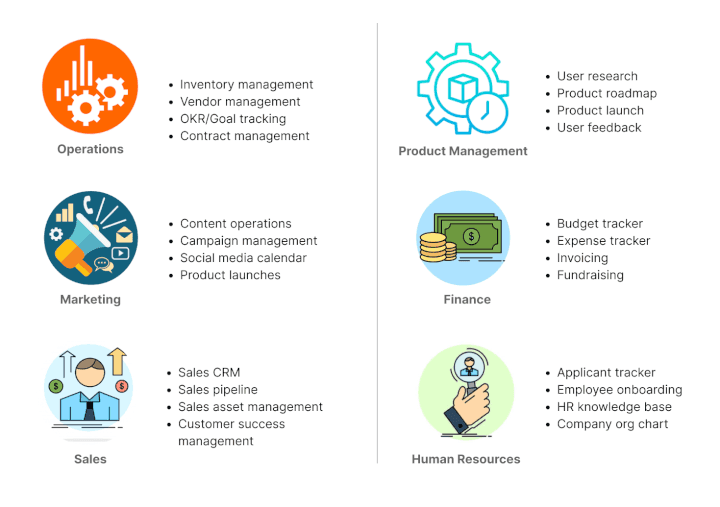
👩🏻💼 From B2C to B2B
Coming out of Beta in early 2015 with 20k-30k users, Airtable’s initial positioning was modeled after consumer/prosumer hits like Evernote and Dropbox. The template gallery was stocked with shopping lists, boy scout management, and other consumer use cases. However, the team quickly recognized that the biggest spikes in growth and actual adoption were coming from businesses and teams. That's when Airtable pivoted to a team-centric B2B bottoms-up approach and set up a small scrappy customer success team to reach out to the largest teams using their product. They were able to spread internally by training users and advocating best practices while not even charging them just yet. This not only minimized churn but also served as a conveyor belt to source insights from these users to take back to the marketing team and contribute to the growth loop.
“Tactically, the things you need for the “land” portion of land and expand is a strong acquisition strategy, an onboarding process that is as easy and frictionless as possible, and, as much as you can, messaging and information that tells the user up front that there is more to your product for the customer to discover so you can seed expansion from the get-go.” - Christy Roach, Head of End-User Marketing, Airtable
Airtable’s biggest driver of growth is still word of mouth. Their arsenal of custom templates and app ecosystems are perfect for users to hit the ground running. The free plan to get you started is a lead magnet for non-technical users with an appetite to build hyper-specific solutions (Persona #1 - the “creator” or the “tinkerer"). The superior design and ease of use compared to the alternatives are guaranteed hooks, but for your team to get the most out of it, you will eventually need to move to one of the paid plans.
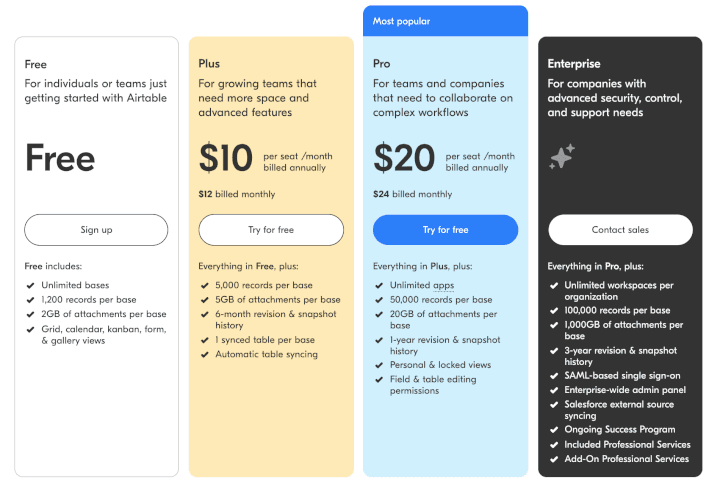
🌎 Something for everybody
“Once you fully understand the value of Airtable, it becomes the way that you think about building out processes in general when you're creating something new." - Zoelle Egner, employee #11 at Airtable
Airtable is built as a collaborative team-centric product by default. Google docs pioneered the idea of real-time collaboration but on a simpler data structure – a long string of characters in this case; Google sheets is essentially a 2D array. But solving the problem of building real-time collaboration around a relational database configured by the end-user is a more challenging problem and where Airtable really comes into its own.
Creators (or tinkerers) can invite others (Persona #2 - the “collaborator”) into workspaces, workflows, and forms that are synced in real-time, quickly scaling horizontally. Airtable pushed three new major feature upgrades in late 2020 to help do this faster, and at the same time curb the need to look beyond the Airtable interface and seek out other ecosystems.
Airtable “Sync” solves a very common pain point that anyone who has ever spent time searching for the latest version of a spreadsheet will relate to – maintaining a single source of truth while enabling live cuts or full views of a database to sync to other separate databases.
“Automations”, that help choose triggers and actions (send emails, update records, and more) to build custom notifications, create and assign work without ever leaving Airtable.
“Apps” – previously called “Blocks”, they live on top of Airtable bases and range from maps, charts, and timelines, which introduce new ways to visualize work.
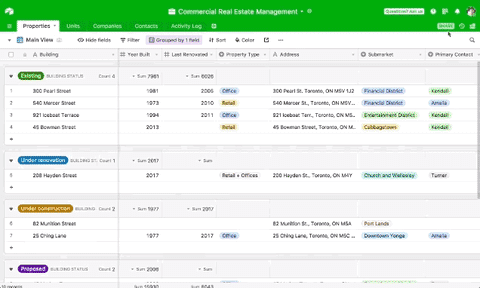
Going enterprise: Although Airtable relies heavily on driving a bottoms-up viral loop for growth, Liu maintains that he has no philosophical opposition to a top-down sales motion. Even though their messaging is focused on creators who are internal champions, it also speaks to decision-makers at the enterprise level who care less about the tactics of how the product works and is more concerned with the value proposition. Airtable appeals to the 'executives' with enterprise offerings including team management tools, dedicated support programs, and organization-wide security nets amongst others.
As Christy Roach, head of end-user marketing at Airtable puts it, “When the rubber meets the road, the website has to talk to both.”
🤝 Hyper-segmented Sales
For everyone who’s acquainted with our GTM breakdowns, this section should be an unsurprising follow-up to the enterprise feature 😌. While personas #1 and #2 are empowered to move up the funnel on their own, enterprise complexities brought about by red tapes, scale, and processes often become tall hurdles. A challenge that is being seamlessly solved by the human-touch Airtable's superior sales machinery provides.
At Airtable, a team of Sales Development Representatives (SDR) and Outbound Business Development Representatives prospects new growth opportunities and qualifies leads for the Direct Sales team of Account Executives (AE's)
'New-Business Account Executives' work exclusively on onboarding/ upselling a premium offering to a new customer, whilst 'Growth Account Executives' drive incremental revenue from existing customers by exploring expansion use cases and opportunities. These teams are further divided on the basis of customer size as Commercial, Emerging business, Large accounts, and Strategic accounts. Sales managers across each bucket drive quota attainment, co-own hiring & training, and manage performance using Salesforce
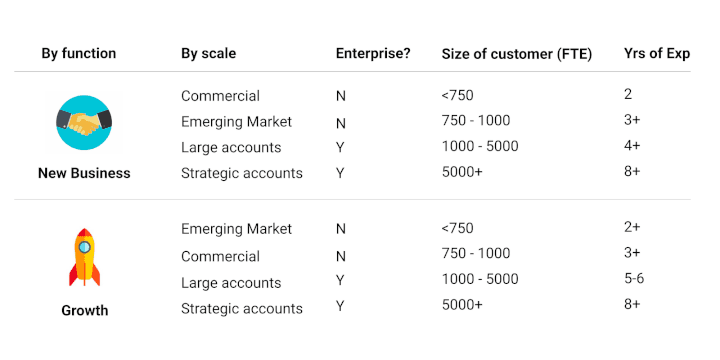
The Customer engagement function headed by CRO Seth Shaw also includes Sales Engineering Blog, Customer Success, Customer Support, Sales enablement, Sales, and GTM Strat-Ops all working in tandem with a single focus of making the customer successful in their pursuit of customized solutions 🤝
⏩ What's next
The world’s most valuable data is still stored either in people’s heads or on disparate Excel sheets. Think data at companies in legacy categories like banking, pharma, insurance, auto, petrochemicals, consumer goods, construction, the list goes on.
“If you can become the place where all the data that operates most businesses goes, the opportunity to build an ecosystem and be the next great platform becomes obvious.” - Sam Lessin of Slow Ventures (joined Airtable’s fundraising in March, 2018).
While even becoming the spiritual successor to Excel is a great market opportunity, Howie maintains that he’s never wanted to just build a productivity or a product management tool. He believes that the product has true scope for major unlocks in the long term by lowering the barrier to app creation, and empowering users with the ability to build custom tools.
In a world desperately in the need of more developers and builders, Airtable's true opportunity is to reduce the barrier for building and add to the world's developer base!
Let's start today's blog a bit differently. We're going to try to sell you a hypothetical product. A product that does everything! 🤩 Customer relationship management, event planning, leave tracking, financial reporting, performance reviews, investor relations, and even your own personal taxes! Sounds too good to be true? What if we told you this product already has 750 million monthly active users? What if we went one further and told you that you are one of these users? Introducing, Microsoft Excel. The most versatile software ever written ⚡️
If you want to see the future of B2B software, look at what Excel users are hacking together in spreadsheets today - Packy McCormick
While Excel was first made to crunch numbers, manage accounts & analyze financials, the software has moved way past its original calling and morphed into an event planner, performance tracker, and sometimes even a game 🙈 (gif below) And that brings us to the founding thesis of one of our favorite products - Airtable!
“If you’re using a spreadsheet for anything other than number-crunching, it should instead be an Airtable” - Airtable's founding thesis

Fast forward to today and Airtable has more than lived up to this thesis. Over 200K organizations use the platform as a LEGO kit for solving a plethora of (often surprising) use-cases:
Tesla uses Airtable to track inventory of vehicles as they leave the factory
While Bret from Idaho uses Airtable to maintain a “calving database” for his cattle. An alternative to his red book used to log vaccinations, pregnancy checks, and other cattle records.
While in some ways, Airtable comes up against Excel and Google Sheets, with a combined user base larger than the population of all but two countries in the world, Airtable's founder and CEO Howie Liu thinks that their low/no-code product can expand the pie rather than compete for it, by lowering the barrier to building applications and empowering people around the world to become creators.
Airtable's fandom of power users often goes as far as describing the product as a spreadsheet on anabolic steroids! 🚀

And this isn't far from the truth! A peek under the hood of this swanky spreadsheet-looking tool reveals a powerful relational database. Here's the story of how Howie Liu, Andrew Ofstad, and Emmett Nicholas, founded and scaled Airtable to an ARR of ~$100M and a valuation of $5.77B. Let's jump right in... 👇🏻
😏 Make databases sexy again
"Spreadsheets are really optimized for numerical analysis and financial calculations. But almost 90% of spreadsheets don't have formulas. Most are used for organizing purposes."
Howie's knack for disruptive innovation is nothing new – back in 2009, he co-founded Etacts, a CRM startup that was acquired by Salesforce within a year. And that was where the "Aha!" moment hit him. He recognized that a large class of useful software was essentially a data model with an interface built on top of it sprinkled with some added customizations. Airtable speaks to the idea of consumerizing that experience, not unlike the Macintosh did for computers. The platform rallies around the central idea that structured processes that form a majority of management, production, and other tasks that represent real work deserve a better home than messy spreadsheets, ad-hoc email chains, and people tapping on shoulders for a single source of truth.

👩🏻💼 From B2C to B2B
Coming out of Beta in early 2015 with 20k-30k users, Airtable’s initial positioning was modeled after consumer/prosumer hits like Evernote and Dropbox. The template gallery was stocked with shopping lists, boy scout management, and other consumer use cases. However, the team quickly recognized that the biggest spikes in growth and actual adoption were coming from businesses and teams. That's when Airtable pivoted to a team-centric B2B bottoms-up approach and set up a small scrappy customer success team to reach out to the largest teams using their product. They were able to spread internally by training users and advocating best practices while not even charging them just yet. This not only minimized churn but also served as a conveyor belt to source insights from these users to take back to the marketing team and contribute to the growth loop.
“Tactically, the things you need for the “land” portion of land and expand is a strong acquisition strategy, an onboarding process that is as easy and frictionless as possible, and, as much as you can, messaging and information that tells the user up front that there is more to your product for the customer to discover so you can seed expansion from the get-go.” - Christy Roach, Head of End-User Marketing, Airtable
Airtable’s biggest driver of growth is still word of mouth. Their arsenal of custom templates and app ecosystems are perfect for users to hit the ground running. The free plan to get you started is a lead magnet for non-technical users with an appetite to build hyper-specific solutions (Persona #1 - the “creator” or the “tinkerer"). The superior design and ease of use compared to the alternatives are guaranteed hooks, but for your team to get the most out of it, you will eventually need to move to one of the paid plans.

🌎 Something for everybody
“Once you fully understand the value of Airtable, it becomes the way that you think about building out processes in general when you're creating something new." - Zoelle Egner, employee #11 at Airtable
Airtable is built as a collaborative team-centric product by default. Google docs pioneered the idea of real-time collaboration but on a simpler data structure – a long string of characters in this case; Google sheets is essentially a 2D array. But solving the problem of building real-time collaboration around a relational database configured by the end-user is a more challenging problem and where Airtable really comes into its own.
Creators (or tinkerers) can invite others (Persona #2 - the “collaborator”) into workspaces, workflows, and forms that are synced in real-time, quickly scaling horizontally. Airtable pushed three new major feature upgrades in late 2020 to help do this faster, and at the same time curb the need to look beyond the Airtable interface and seek out other ecosystems.
Airtable “Sync” solves a very common pain point that anyone who has ever spent time searching for the latest version of a spreadsheet will relate to – maintaining a single source of truth while enabling live cuts or full views of a database to sync to other separate databases.
“Automations”, that help choose triggers and actions (send emails, update records, and more) to build custom notifications, create and assign work without ever leaving Airtable.
“Apps” – previously called “Blocks”, they live on top of Airtable bases and range from maps, charts, and timelines, which introduce new ways to visualize work.

Going enterprise: Although Airtable relies heavily on driving a bottoms-up viral loop for growth, Liu maintains that he has no philosophical opposition to a top-down sales motion. Even though their messaging is focused on creators who are internal champions, it also speaks to decision-makers at the enterprise level who care less about the tactics of how the product works and is more concerned with the value proposition. Airtable appeals to the 'executives' with enterprise offerings including team management tools, dedicated support programs, and organization-wide security nets amongst others.
As Christy Roach, head of end-user marketing at Airtable puts it, “When the rubber meets the road, the website has to talk to both.”
🤝 Hyper-segmented Sales
For everyone who’s acquainted with our GTM breakdowns, this section should be an unsurprising follow-up to the enterprise feature 😌. While personas #1 and #2 are empowered to move up the funnel on their own, enterprise complexities brought about by red tapes, scale, and processes often become tall hurdles. A challenge that is being seamlessly solved by the human-touch Airtable's superior sales machinery provides.
At Airtable, a team of Sales Development Representatives (SDR) and Outbound Business Development Representatives prospects new growth opportunities and qualifies leads for the Direct Sales team of Account Executives (AE's)
'New-Business Account Executives' work exclusively on onboarding/ upselling a premium offering to a new customer, whilst 'Growth Account Executives' drive incremental revenue from existing customers by exploring expansion use cases and opportunities. These teams are further divided on the basis of customer size as Commercial, Emerging business, Large accounts, and Strategic accounts. Sales managers across each bucket drive quota attainment, co-own hiring & training, and manage performance using Salesforce

The Customer engagement function headed by CRO Seth Shaw also includes Sales Engineering Blog, Customer Success, Customer Support, Sales enablement, Sales, and GTM Strat-Ops all working in tandem with a single focus of making the customer successful in their pursuit of customized solutions 🤝
⏩ What's next
The world’s most valuable data is still stored either in people’s heads or on disparate Excel sheets. Think data at companies in legacy categories like banking, pharma, insurance, auto, petrochemicals, consumer goods, construction, the list goes on.
“If you can become the place where all the data that operates most businesses goes, the opportunity to build an ecosystem and be the next great platform becomes obvious.” - Sam Lessin of Slow Ventures (joined Airtable’s fundraising in March, 2018).
While even becoming the spiritual successor to Excel is a great market opportunity, Howie maintains that he’s never wanted to just build a productivity or a product management tool. He believes that the product has true scope for major unlocks in the long term by lowering the barrier to app creation, and empowering users with the ability to build custom tools.
In a world desperately in the need of more developers and builders, Airtable's true opportunity is to reduce the barrier for building and add to the world's developer base!
Related Articles




Behavioral Retargeting: A Game-Changer in the Cookieless Era
Unlock the power of behavioral retargeting for the cookieless future! Learn how it personalizes ads & boosts conversions. #behavioralretargeting




All of Toplyne's 40+ Badges in the G2 Spring Reports
Our customers awarded us 40+ badges in G2's Summer Report 2024.




Unlocking the Full Potential of Google PMax Campaigns: Mastering Audience Selection to Double Your ROAS
Copyright © Toplyne Labs PTE Ltd. 2024
Copyright © Toplyne Labs PTE Ltd. 2024
Copyright © Toplyne Labs PTE Ltd. 2024
Copyright © Toplyne Labs PTE Ltd. 2024